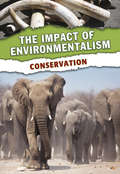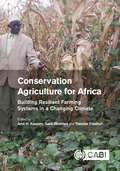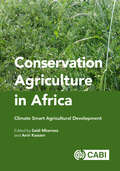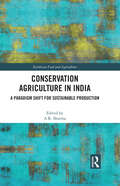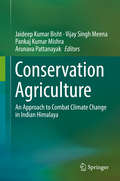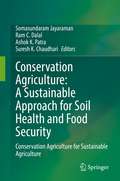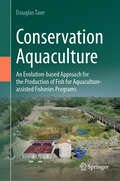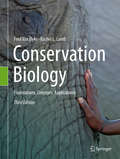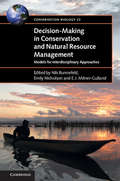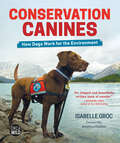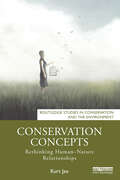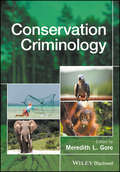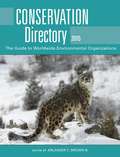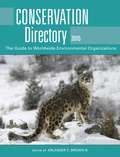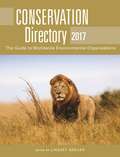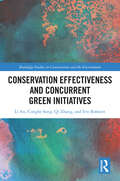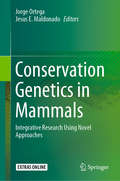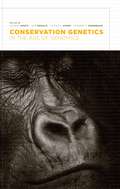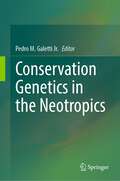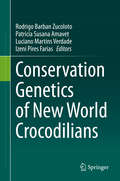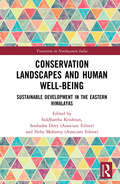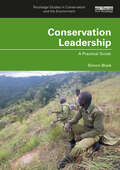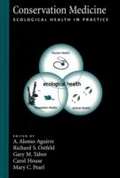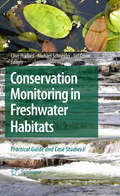- Table View
- List View
Conservation (The Impact of Environmentalism)
by Jen GreenWe are all aware of the importance of the environment - it's in the news, it affects our behavior and the decisions we make every day. But what actual impact has environmental thinking had on the world around us? This thought-provoking book looks at the way changing ideas about the environment and sustainability have affected our attitudes to conservation, and will do so in the future.
Conservation Agriculture for Africa: Building Resilient Farming Systems in a Changing Climate
by Dennis Dennis Peter Dorward Michael Misiko John A. Pickett J N Blignaut H Boulal Roland Bunch Trent W Bunderson Oussama El Gharras Mohammed El Mourid Mphatso Gama Zwide D Jere Josef Kienzle Jaap Knot Erna Kruger Peter Kuria Baqir Lalani Simon Lugandu Brand Mbale Charles Midega Zeyaur Khan Obedi Mkandawire Alice Murage Richard M. Museka Weldone Mutai Blessings M. Mwale Spencer W.D. Ng’oma John M. Paul Jimmy Pittchar Brian G. Sims Hendrik J. Smith Phillip Tembo Christian Thierfelder Patrick C. Wall Reynolds K. Shula Jose DambiroTillage agriculture has led to widespread soil and ecosystem degradation. This book reviews research and development initiatives in Africa aimed at building resilient farming systems. It summarises the status of conservation agriculture today, discusses prospects for future development and provides case studies showing its performance in Africa.
Conservation Agriculture in Africa: Climate Smart Agricultural Development
by Neil Miller Richard Bell Patrick Gicheru Trent W Bunderson Zwide D Jere Josef Kienzle Erna Kruger Peter Kuria Simon Lugandu Weldone Mutai Brian G. Sims Hendrik J. Smith Christian Thierfelder Reynolds K. Shula Johann Strauss Joseph Mureithi Mohamed Annabi Haithem Bahri Mloza Banda Gotlieb Basch Alexandra Bot Martin Bwalya Hatem Cheikh M’hamed Cornelius Chiduza Cary Clark Demba Diakhaté Mazwi Dlamini Sjoerd Duiker Alioune Fall Aymen Frija Josiah Gitari Tom Goddard Emilio Gonzalez-Sanchez Isaac Gura Enamul Haque Michel Havard Zied Idoudi Mohammad Jahiruddin Onesmos Kitonyo Phlorentin Philip Lagwen Ngari Macharia Temakholo Mathebula Sixolise Mcinga Alfred Micheni Frank Mmbando Rachid Moussadek Pearson Nyari Mnkeni Rachid Mrabet Ndabhemeye Mulengera Walter Mupangwa R. M. Museka Munyaradzi Mutenje Lindah Muzangwa Remmy Mwakimbwala Andre A Nel James Njeru Rama Ngatoluwa Phumzile Ngcobo Isaiah Nyagumbo Putso Nyathi Ricardo Ralisch Leonard Rusinamhodzi John Sariah Ibrahima Sarr Peter Setimela Richard Shetto Dimas Soares Júnior Peter Steward Gerhardus Trytsman Jean Twilingiyumukiza Carl Wahl Peter Waweru Nouhoun ZampaligreTillage agriculture has led to widespread soil and ecosystem degradation globally, and more particularly in the developing regions. This is especially so in Africa where traditional agricultural practices have become unsustainable due to severe exploitation of natural resources with negative impacts on the environment and food system. In addition, agricultural land use in Africa today faces major challenges including increased costs, climate change and a need to transform to more sustainable production intensification systems. Conservation Agriculture has emerged as a major alternative sustainable climate smart agriculture approach in Africa and has spread to many African countries in the past decade as more development and research, including in sustainable mechanization, has enabled its extension and uptake. It is key to transforming Africa's agriculture and food system given its ability to restore soil health, biodiversity and productivity of millions of smallholder farms as well as larger-scale farms. This landmark volume is based on the material presented at the Second Africa Congress on Conservation Agriculture which was held in Johannesburg, South Africa, 9-12 October 2018. The main theme of the Congress was 'Making Climate Smart Agriculture Real in Africa with Conservation Agriculture: Supporting the Malabo Declaration and Agenda 2063'. The Congress was aligned to mobilize stakeholders in all agriculture sectors to provide greater technical, institutional, development and investment support, impetus and direction to the vision and agenda for transforming African agriculture as set out by the Malabo Declaration and Agenda 2063. This book is aimed at all agricultural stakeholders in the public, private and civil sectors in Africa engaged in supporting the transformation of conventional tillage agriculture to Conservation Agriculture. The book will be of interest to: researchers, academics, students, development stakeholders, public and private sector investors and policy makers as well as institutional libraries across the world.
Conservation Agriculture in India: A Paradigm Shift for Sustainable Production (Earthscan Food and Agriculture)
by A. R. SharmaThis book examines the current situation, levels of adoption, management practices, and the future outlook of conservation agriculture in India, and also in other tropical and subtropical regions of the world. While conservation agriculture is proposed as an important means to combat climate change, improve crop productivity and food affordability, and to protect the environment, the adoption of conservation agriculture in India, and south-east Asia more broadly, has been slow. This volume reflects on the current status of conservation agriculture in India, asking why adoption has been slow and putting forward strategies to improve its uptake. The chapters cover the various aspects of crop management such as soil, water, nutrients, weeds, crop residues, machinery, and energy, in a range of environments, including irrigated and rainfed regions. The impact of climate change and the economic considerations behind the adoption of conservation agriculture are also discussed. The volume concludes by discussing the future outlook for conservation agriculture in India, in particular drawing out parallels with other tropical and subtropical regions of the world. This book will be of great interest to students and scholars of conservation agriculture, sustainable agriculture, crop and soil management, and environmental and natural resource management.
Conservation Agriculture: An Approach to Combat Climate Change in Indian Himalaya
by Jaideep Kumar Bisht Vijay Singh Meena Pankaj Kumar Mishra Arunava PattanayakThis book showcases a compilation of case studies presented by scientists, teachers and academics and covers contemporary technologies for combating climate change, including sustainable agricultural management practices and conservation agriculture. It highlights the situations that future generations in the Indian Himalayas will face, and addresses the major challenges for tomorrow's generations in their efforts to ensure sufficient food production for the global population. It also sheds light on the factors that are routinely ignored in connection with agricultural management practices for sustainable food production and risk assessment. Lastly, it illustrates the need to develop a comprehensive master plan for strategic planning, including conservation agriculture practices that address poverty and food security in the wake of climate change impacts.
Conservation Agriculture: Conservation Agriculture for Sustainable Agriculture
by Ashok K. Patra Ram C. Dalal Somasundaram Jayaraman Suresh K. ChaudhariFeeding the increasing global population, which is projected to reach ~10 billion by 2050, there has been increasing demands for more improved/sustainable agricultural management practices that can be followed by farmers to improve productivity without jeopardizing the environment and ecosystem. Indeed, about 95% of our food directly or indirectly comes from soil. It is a precious resource, and sustainable soil management is a critical socio–economic and environmental issue. Maintaining the environmental sustainability while the world is facing resource degradation, increasing climate change and population explosion is the current challenge of every food production sectors. Thus, there is an urgent need to evolve a holistic approach such as conservation agriculture to sustain higher crop productivity in the country without deteriorating soil health. Conservation Agriculture (CA), is a sustainable approach to manage agro–ecosystems in order to improve productivity, increase farm profitabilty and food security and also enhance the resource base and environment. Worldwide, it has been reported various benefits and prospects in adopting CA technologies in different agro-climatic conditions. Yet, CA in arid and semi-arid regions of India and parts of south Asia raises uncertainities due to its extreme climates, large scale residue burning, soil erosion and other constraints such as low water holding capacity, high potential evapotranspiration, etc . Thus, the proposed book has 30 chapters addressing all issues relevant to conservation agriculture/no-till farming system. The book also gives further strengthening existing knowledge in relation to soil physical, chemical and biological processes and health within close proximity of CA as well as machinery requirements. Moreover, the information on carbon (C) sequestration, C credits, greenhouse gas (GHG) emission, mitigation of climate change effects and socio-economic view on CA under diverse ecologies namely rainfed, irrigated and hill eco-region is also deliberated. For large scale adoption of CA practices in South Asian region especially in India and other countries need dissemination of best-bet CA technologies for dominant soil types/cropping systems through participatory mode, strong linkages and institutional mechanism and public-private-policy support.We hope this book gives a comprehensive and clear picture about conservation agriculture/no-till farming and its associated problem, challenges, prospects and benefits. This book shall be highly useful reference material to researchers, scientists, students, farmers and land managers for efficient and sustainable management of natural resources.
Conservation Aquaculture: An Evolution-based Approach for the Production of Fish for Aquaculture-assisted Fisheries Programs
by Douglas TaveStocking hatchery-produced fish has been a standard component of fisheries management for over 100 years. This book discusses the production of hatchery fish used in aquaculture-assisted fisheries programs to help stabilize and recover endangered species. For the most part, these programs have been unsuccessful, and a reason why is that the traditional approach to fish culture produces fish that are genetically and behaviorally ill-suited to help recover an imperiled species. The hatchery environment and management used to culture the fish makes them sub-viable in the wild. Even if most of the augmented fish die, survivors that mate with wild fish lower the fitness of the endangered population, making the conservation program counter-productive. Since traditional aquaculture programs have been shown to produce fish that are ill-suited to help recovery, a new way of producing fish is needed. That new way is conservation aquaculture. In conservation aquaculture, fish are raised in naturalized mesocosms that mimic the environment in which the endangered species lives. Management is naturalized, so domestication does not produce genetic changes, and so fish develop a full and effective suite of behaviors that enable them to forage efficiently and detect and avoid predators when stocked. The conservation aquaculture management techniques described in the book can also be used to improve commercial and recreational fish stocking programs.
Conservation Biology: Conservation Behavior
by David Saltz Berger-Tal, Oded and Saltz, David Oded Berger-TalConservation behavior assists the investigation of species endangerment associated with managing animals impacted by anthropogenic activities. It employs a theoretical framework that examines the mechanisms, development, function, and phylogeny of behavior variation in order to develop practical tools for preventing biodiversity loss and extinction. Developed from a symposium held at the International Congress on Conservation Biology in 2011, this is the first book to offer an in-depth, logical framework that identifies three vital areas for understanding conservation behavior: anthropogenic threats to wildlife, conservation and management protocols, and indicators of anthropogenic threats. Bridging the gap between behavioral ecology and conservation biology, this volume ascertains key links between the fields, explores the theoretical foundations of these linkages, and connects them to practical wildlife management tools and concise applicable advice. Adopting a clear and structured approach throughout, this book is a vital resource for graduate students, academic researchers, and wildlife managers.
Conservation Biology: Foundations, Concepts, Applications
by Rachel L. Lamb Fred Van DykeThis book provides a thorough, up-to-date examination of conservation biology and the many supporting disciplines that comprise conservation science. In this, the Third Edition of the highly successful Conservation Biology: Foundations, Concepts, Applications, the authors address their interdisciplinary topic as it must now be practiced and perceived in the modern world. Beginning with a concise review of the history of conservation, the authors go on to explore the interplay of conservation with genetics, demography, habitat and landscape, aquatic environments, and ecosystem management, and the relationship of all these disciplines to ethics, economics, law, and policy. An entirely new chapter, The Anthropocene: Conservation in a Human-Dominated Nature, breaks new ground in its exploration of how conservation can be practiced in anthropogenic biomes, novel ecosystems, and urban habitats. The Third Edition includes the popular Points of Engagement discussion questions used in earlier editions, and adds a new feature: Information Boxes, which briefly recap specific case histories described in the text. A concluding chapter offers insight into how to become a conservation professional, in both traditional and non-traditional roles.The authors, Fred Van Dyke and Rachel Lamb, draw on their expertise as field biologists, wildlife managers, consultants to government and industry, and scholars of environmental law, policy, and advocacy, as well as their many years of effective teaching experience. Informed by practical knowledge and acquired skills, the authors have created a work of exceptional clarity and readability which encompasses both systemic foundations as well as contemporary developments in the field. Conservation Biology: Foundations, Concepts, Applications will be of invaluable benefit to undergraduate and graduate students, as well as to working conservation scientists and managers.This is an amazing resource for students, faculty, and practitioners both new and experienced to the field. Diane Debinski, PhD Unexcelled wisdom for living at home on Wonderland Earth, the planet with promise, destined for abundant life. Holmes Rolston, PhDVan Dyke and Lamb have maintained the original text’s emphasis on connecting classical ecological and environmental work with updated modern applications and lucid examples. But more importantly, the third edition contains much new material on the human side of conservation, including expanded treatments of policy, economics, and climate change. Tim Van Deelen, PhD Fred Van Dyke and Rachel Lamb break new ground in both the breadth and depth of their review and analysis of this crucially important and rapidly changing field. Any student or other reader wishing to have a comprehensive overview and understanding of the complexities of conservation biology need look no further – this book is your starting point! Simon N. Stuart, PhDAnyone who teaches, talks or writes and works on Conservation Biology, needs this latest edition of Conservation Biology (Foundations, Concepts, Applications, 3rd edition) by Fred Van Dyke and Rachel L. Lamb. This will be useful to both beginners and experts as well. The authors included almost all important issues in relation to conservation biology. This is really an outstanding book. Bidhan Chandra Das, Professor, Ecology Branch, Department of Zoology, University of Rajshahi, Bangladesh
Conservation Biology: Models for Interdisciplinary Approaches (Conservation Biology #22)
by E. J. Nils Bunnefeld Emily Nicholson Milner-GullandMaking decisions about the management and conservation of nature is necessarily complex, with many competing pressures on natural systems, opportunities and benefits for different groups of people and a varying, uncertain social and ecological environment. An approach which is narrowly focused on either human development or environmental protection cannot deliver sustainable solutions. This volume provides frameworks for improving the integration of natural resource management with conservation and supporting stronger collaboration between researchers and practitioners in developed and developing countries. Novel approaches are required when ecological and social dynamics are highly interdependent. A structured, participatory, model-based approach to decision-making for biodiversity conservation has been proven to produce real-world change. There are surprisingly few successful case studies, however; some of the best are presented here, from fisheries, pest management and conservation. Researchers and practitioners need this interdisciplinary approach, focused on quantitative tools that have been tested and applied, and learning from success.
Conservation Canines: How Dogs Work for the Environment (Orca Wild #7)
by Isabelle GrocKey Selling Points The book examines how dogs are chosen and trained for conservation work and details the kind of work they do all over the world, in Africa, Italy, Portugal, France, Australia, Haida Gwaii and the United States. The author is a highly respected photojournalist, filmmaker and the author of Gone is Gone: Wildlife Under Threat and Sea Otters: A Survival Story, which are also part of the Orca Wild series. Isabelle Groc's stunning photos of working dogs give the book a hands-on feel. For fans of the TV show Dogs With Jobs—but for the environment! Includes a foreword by award-winning actor, director, producer and author Anjelica Huston.
Conservation Concepts: Rethinking Human–Nature Relationships (Routledge Studies in Conservation and the Environment)
by Kurt JaxThis book provides a review of the multitude of conservation concepts, both from a scientific, philosophical, and social science perspective, asking how we want to shape our relationships with nature as humans, and providing guidance on which conservation approaches can help us to do this. Nature conservation is a contested terrain and there is not only one idea about what constitutes conservation but many different ones, which sometimes are conflicting. Employing a conceptual and historical analysis, this book sorts and interprets the differing conservation concepts, with a special emphasis on narrative analysis as a means for describing human–nature relationships and for linking conservation science to practice and to society at large. Case studies illustrate the philosophical issues and help to analyse major controversies in conservation biology. While the main focus is on Western ideas of conservation, the book also touches upon non-Western, including indigenous, concepts. The approach taken in this book emphasises the often implicit strategic and societal dimensions of conservation concepts, including power relations. In finding a path through the multitude of concepts, the book showcases that it is necessary to maintain the plurality of approaches, in order to successfully address different situations and societal choices. Overall, this book highlights the very tension which conservation biology must withstand between science and society: between what is possible and what we want individually or as a society or even more what is desirable. Bringing some order into this multitude will support more efficient conservation and conservation biology. This book will be of great interest to students and scholars studying nature conservation from a variety of disciplines, including biology, ecology, anthropology, sociology, geography, and philosophy. It will also be of use to professionals wanting to gain an understanding of the broad spectrum of conservation concepts and approaches and when to apply them.
Conservation Criminology
by Meredith L. GoreThis important new text introduces conservation criminology as the interdisciplinary study of environmental exploitation and risks at the intersection of human and natural systems. Taking an interdisciplinary approach, the book enhances understanding of the various human and organizational behaviors that pose risks to the environment, humans, and drive conservation crime. As human population growth, global market economies, climate change, deforestation, and illegal exploitation of natural resources continue to increase, academic research from numerous disciplines is needed to address these challenges. Conservation Criminology promotes thinking about how unsustainable natural resources exploitation is a cause and a consequence of social conflict. Case studies profiled in the book demonstrate this cause and effect type situation, as well as innovative approaches for reducing risks to people and the environment. This text encourages readers to consider how humans behave in response to environmental risks and the various mechanisms that constitute effective and ineffective approaches to enforcement of wildlife crimes, including environmental and conservation policy. Case studies from the USA, Latin America, Africa, and Asia highlight corruption in conservation, global trade in electronic waste, illegal fishing, illegal logging, human-wildlife conflict, technology and space, water insecurity, wildlife disease, and wildlife poaching. Taken together, chapters expand the reader’s perspective and employ tools to understand and address environmental crimes and risks, and to provide novel empirical evidence for positive change. With established contributors providing interdisciplinary and global perspectives, this book establishes a foundation for the emerging field of conservation criminology.
Conservation Directory 2015
by FederationThe 2015 edition of National Wildlife Federation's Conservation Directory is the most comprehensive listing of conservation and environmental organizations yet published, with information on more than 4,000 government agencies, nongovernmental organizations, and colleges and universities, as well as more than 18,000 officials concerned with environmental conservation, education, and natural resource use and management.Each entry contains detailed contact information, including names, addresses, and telephone numbers. Also included are selected email and Internet addresses, descriptions of program areas, senior staff by name and responsibility, principal publications, and more. Entries are categorized by organization and state or country and are indexed alphabetically and by subject on topics ranging from acid rain to zoology. Each person listed in the directory is also indexed alphabetically
Conservation Directory 2015: The Guide to Worldwide Environmental Organizations
by Arlander C. BrownThe authority on natural resource use and management agencies around the world.Do you want to take action to protect Earth’s environment? Are you interested in learning more about wildlife conservation and environmental groups? The Conservation Directory 2015 is a great resource for budding environmental activists and scholars alike who want to achieve a peaceful, equitable, and sustainable future. This all-inclusive volume is an amazing resource that can help further these environmental goals.The new and revised 2015 edition of the Conservation Directory is the most comprehensive listing of conservation and environmental organizations yet published, with information on more than four thousand government agencies, nongovernmental organizations, and colleges and universities, as well as more than eighteen thousand officials concerned with environmental conservation, education, and natural resource use and management.Each entry contains detailed contact information, including names, addresses, and telephone numbers. Also included are selected email and Internet addresses, descriptions of program areas, senior staff by name and responsibility, principal publications, and more. Entries are categorized by organization and state or country and are indexed alphabetically and by subject on topics ranging from acid rain to zoology. Each person listed in the directory is also indexed alphabetically.
Conservation Directory 2017: The Guide to Worldwide Environmental Organizations
by Lindsey BreuerDo you want to take action to protect Earth’s environment? Are you interested in learning more about wildlife conservation and environmental groups? The Conservation Directory 2017 is a great resource for budding environmental activists and scholars alike who want to achieve a peaceful, equitable, and sustainable future. This all-inclusive volume is an amazing resource that can help further these environmental goals.The new and revised 2017 edition of the Conservation Directory is the most comprehensive listing of conservation and environmental organizations yet published, with information on more than four thousand government agencies, nongovernmental organizations, and colleges and universities, as well as more than eighteen thousand officials concerned with environmental conservation, education, and natural resource use and management.Each entry contains detailed contact information, including names, addresses, and telephone numbers. Also included are selected email and Internet addresses, descriptions of program areas, senior staff by name and responsibility, principal publications, and more. Entries are categorized by organization and state or country and are indexed alphabetically and by subject on topics ranging from acid rain to zoology. Each person listed in the directory is also indexed alphabetically.
Conservation Effectiveness and Concurrent Green Initiatives (Routledge Studies in Conservation and the Environment)
by Qi Zhang Li An Conghe Song Eve BohnettThe book examines concurrent green initiatives and their spillover effects on environmental conservation and management to reveal their impact on conservation effectiveness, drawing on a range of international case studies. Green initiatives are programs, payments, or endeavors that restore, sustain, or improve nature’s capacity, with examples including payments for ecosystem services and the development of nature reserves and protected areas. This book explicitly examines concurrent green initiatives, where initiatives overlap either geographically or in terms of recipients of multiple payments. The book provides a detailed analysis of case studies in the USA and China, including the USA-based Conservation Reserve Program and the Environmental Quality Incentives Program, and the China based Grain-to-Green Program and the Forest Ecological Benefit Compensation Fund. Through this comparison, the book shows the impact of concurrent green initiatives, including additional or unintended benefits for conservation and local communities as well as negative spillover effects. The book complements these case studies by drawing on other global examples ranging in size from local to continental, including planting native trees and shrubs in Australia and green initiatives in the Baltic Sea region. Overall, this book demonstrates the importance of analyzing concurrent green efforts to better understand both the positive and negative impacts to ensure the optimal effectiveness of these policies and programs for conservation and environmental management. This book will be of great interest to students and scholars of environmental conservation and management, land use, ecosystem services and environmental policy, as well as policymakers and practitioners working on environmental initiatives and programs.
Conservation Genetics in Mammals: Integrative Research Using Novel Approaches
by Jorge Ortega Jesus E. MaldonadoThis book focuses on the use of molecular tools to study small populations of rare and endangered mammals, and presents case studies that apply an evolutionary framework to address innovative questions in the emerging field of mammalian conservation genomics using a highly diverse set of novel molecular tools. Novel and more precise molecular technologies now allow experts in the field of mammology to interpret data in a more contextual and empirical fashion and to better describe the evolutionary and ecological processes that are responsible for the patterns they observe. The book also demonstrates how recent advances in genetic/genomic technologies have been applied to assess the impact of environmental/anthropogenic changes on the health of small populations of mammals. It examines a range of issues in the field of mammalian conservation genomics, such as the role that the genetic diversity of the immune system plays in disease protection and local adaptation; the use of noninvasive techniques and genomic banks as a resource for monitoring and restoring populations; the structuring of population by physical barriers; and genetic diversity. Further, by integrating research from a variety of areas – including population genetics, molecular ecology, systematics, and evolutionary and conservation biology – it enables readers to gain a deeper understanding of the conservation biology of mammals that are at increasing risk of extinction at local, regional and global scales. As such, it offers a unique resource for a broad readership interested in the conservation biology of mammals and conservation management strategies to better preserve biodiversity.
Conservation Genetics in the Age of Genomics (American Museum of Natural History, Center for Biodiversity Conservation, Series on Biodiversity)
by George Oliver A. Ryder Howard C. Rosenbaum Rob DeSalle Eds. AmatoGenome sequencing enables scientists to study genes over time and to test the genetic variability of any form of life, from bacteria to mammals. Thanks to advances in molecular genetics, scientists can now determine an animal's degree of inbreeding or compare genetic variation of a captive species to wild or natural populations. Mapping an organism's genetic makeup recasts such terms as biodiversity and species and enables the conservation of rare or threatened species, populations, and genes. By introducing a new paradigm for studying and preserving life at a variety of levels, genomics offers solutions to previously intractable problems in understanding the biology of complex organisms and creates new tools for preserving the patterns and processes of life on this planet. Featuring a number of high-profile researchers, this volume introduces the use of molecular genetics in conservation biology and provides a historical perspective on the opportunities and challenges presented by new technologies. It discusses zoo-, museum-, and herbarium-based biological collections, which have expanded over the past decade, and covers the promises and problems of genomic and reproductive technology. The collection concludes with the philosophical and legal issues of conservation genetics and their potential effects on public policy.
Conservation Genetics in the Neotropics
by Pedro M. GalettiThis book explores how genetics and the new technologies in genomics have been used for conservation of plants and animals in the Neotropics. It shows the new perspective for conservation genetics beyond the use of theoretical and methods in genetics at species level and presents how genetics and genomics can be used for assessing communities. Conservation genetics and genomics are presented as a helpful field of study for resolving taxonomic uncertainties and hidden biodiversity, understanding populations and extinction risk, genetic management, wildlife forensic genetics, assessing biology and molecular ecology, assessing communities, conservation genomics and the use of conservation biology and genetics in science learning, highlighting case studies in the Neotropics. Applications of conservation genetics for management or policy, decision making, planning, and implementation of conservation practice in the Neotropics are addressed across chapters. This book will interest to researchers and students in conservation genetics and biology conservation interested in the Neotropics. Stakeholders and decision makers in conservation biology may also find this book useful.
Conservation Genetics of New World Crocodilians
by Rodrigo Barban Zucoloto Patricia Susana Amavet Luciano Martins Verdade Izeni Pires FariasThis book aims to be a comprehensive review of the literature on the conservation genetics of the New World crocodilians, from the biological and demographical aspects of the living species to the application of molecular techniques for conservation purposes. It covers the current status of the molecular genetics applied to phylogenetics, phylogeography, diversity, kinship and mating system, and hybridization, as well its implications for decision making with regards to the conservation of these species at academic and governmental levels. This book can be used as a guide for graduate and undergraduate students to understand how conservation genetics techniques are carried out and how they can help preserve not only crocodilians but also other living species.
Conservation Landscapes and Human Well-Being: Sustainable Development in the Eastern Himalayas (Transition in Northeastern India)
by Siddhartha KrishnanThe Himalayas are said to be the youngest mountain ranges in the world. This book studies the well-being of the eastern Himalayan forest-dwellers in terms of their capabilities and functioning. Using Amartya Sen’s and Martha Nussbaum’s Capabilities Approach, it examines the educational and health opportunities and substantial freedoms afforded to farmers and pastoralists living and working in the Senchal and Singalila Protected Areas of North Bengal, India. It also discusses the challenges and potential of the Forest Rights Act as a well-being delivery mechanism. The book adopts a comparative narrative of socio-ecological information generated from interviews, ecological field methods, remote sensing and participatory rural appraisals to provide insight on human development in conservation contexts. This volume will be of interest to students and researchers of conservation biology, development studies, socio-ecological systems studies, political ecology, human development index, ecological economics, environmental sociology, and South Asian studies. It will also be useful to policy-makers and NGOs in the conservation and livelihoods sector.
Conservation Leadership: A Practical Guide (Routledge Studies in Conservation and the Environment)
by Simon BlackThis book is an important guide for individuals seeking to develop and grow their leadership skills in the wildlife conservation sector, across varied disciplines such as environmental management, conservation biology, and ecotourism.Conservation Leadership addresses what leadership is, why it is important, and how to be an effective leader. It identifies the common pitfalls or mistakes in a leader’s thinking or behaviour, and the unexpected consequences or responses which can arise, and then explores more helpful alternative approaches to leadership. The book is divided into three parts: Part I: Leadership principles Part II: Four areas of profound theory: knowledge, psychology, systems, and variation Part III: Skills and competencies for conservation leaders It focuses on contextual and organisational challenges in conservation, including limited resources, remote locations, fragile species of concern, politics, community conflict, crime, and commercial pressures. The scope is global, using diverse examples such as sea turtle head-starting in South Asia, reforestation in North Africa, bird conservation in North America, human–wildlife interactions in the Himalayas, and post-colonial issues in the Caribbean. Case studies illustrate key learning points from small local teams through to global transnational initiatives. Exercises in each chapter enable the exploration of less-familiar topics, including interpersonal skills, goal setting and performance measurement, plus a unique research-derived conservation leadership self-assessment tool.This book is an essential reading resource for professionals and senior leaders in the wildlife management and conservation sector, as well as students on biodiversity conservation, wildlife conservation, and environmental management courses.
Conservation Medicine: Ecological Health in Practice
by Carol House Richard Ostfeld Gary Tabor Mary Pearl A. AguirreConservation medicine is an emerging discipline, focussing on the intersection of ecosystem health, animal health, and human health. Work in the biomedical and veterinary sciences is now being folded into conservation biology; to explore the connections between animal and human health; trace the environmental sources of pathogens and pollutants; develop an understanding of the ecological causes of changes in human and animal health; and understand the consequences of diseases to populations and ecological communities.Conservation Medicinedefines this new discipline. It examines ecological health issues from various standpoints, including the emergence and resurgence of infectious disease agents; the increasing impacts of toxic chemicals and hazardous substances; and the health implications of habitat fragmentation and degradation and loss of biodiversity. It will provide a framework to examine the connections between the health of the planet and the health of all species and challenge practitioners and students in the health sciences and natural sciences to think about new, collaborative ways to address ecological health concerns.
Conservation Monitoring in Freshwater Habitats: A Practical Guide and Case Studies
by Michael Schneider Clive Hurford Ian CowxThe predicted changes to global weather patterns and increases in the human population will put unprecedented pressure on European freshwater habitats and the species that depend on them. Our success in conserving the ecological value of these habitats will depend greatly on carefully planned conservation management integrated with efficient and reliable monitoring. "Conservation Monitoring in Freshwater Habitats" focuses on the need to develop clear, site-specific, conservation management goals; something rarely considered in previous publications on freshwater monitoring. The early chapters explore the use of biological indicators for monitoring and provide practical guidance for developing and implementing efficient and reliable monitoring projects. The remainder of the book is dedicated to a series of carefully selected case studies illustrating best practice in both decision-making and application across a range of habitats and species. This timely book will provide a valuable reference for students and researchers in biological and environmental sciences, and for practitioners working in government departments, conservation organizations and ecological consultancies. It will be an essential resource for anyone working towards fulfilling the requirements of both the Water Framework Directive and the EC Habitats Directive.
